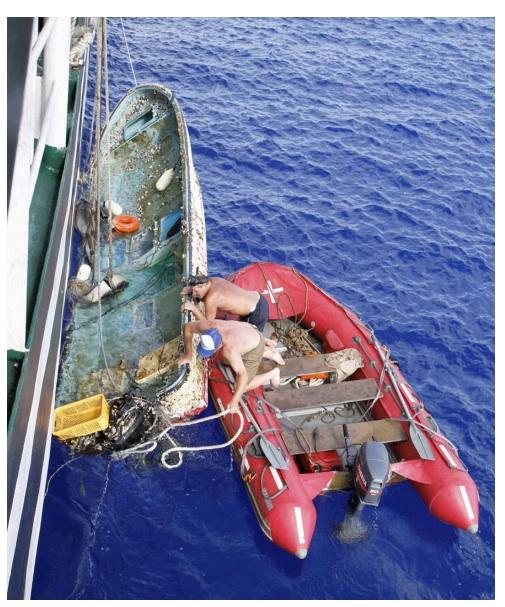
When Will Japan's Tsunami Debris Hit North America?

This much is known: The devastating earthquake and tsunami that hit Japan on March 11 created a massive amount of debris, some of which was washed back into the ocean as the waters retreated. Prevailing currents are carrying that debris toward the United States.
But when and where — if ever — it will wash ashore is still in question, and scientists are still tracking how much is floating toward the West Coast.
The magnitude-9.0 quake and tsunami — the costliest disaster of all time — were so powerful that they broke off huge icebergs thousands of miles away in the Antarctic, locally altered Earth's gravity field and washed millions of tons of debris into the Pacific. The Japanese government estimated that the tsunami generated 25 million tons of rubble, but no one is sure how much of that washed into the ocean, or whether any debris stayed afloat.
"It's difficult to say exactly how much debris is expected to show up, and when and where," said Dianna Parker, a spokeswoman with the NOAA Marine Debris Program.
Not much to see
Not helping the trackers is that they can no longer see the piles of debris by satellite. Winds and ocean currents scattered items in the massive North Pacific Ocean.
Since trackers cannot rely on satellites, they are using computer models to guess where the debris will go. NOAA's model estimates that debris could show up in Hawaii as early as this winter. The West Coast could see debris in 2013, and the debris could circle back to Hawaii some time between 2014 and 2016, Parker told OurAmazingPlanet.
Sign up for the Live Science daily newsletter now
Get the world’s most fascinating discoveries delivered straight to your inbox.
But there are many limitations to the forecast; debris could sink or break up and disperse in the ocean.
"We're preparing for high amounts of debris, but we're also preparing for little to nothing," Parker said.
Another problem is distinguishing debris from the quake from trash floating in the ocean from other sources. Two fishing vessels found in the middle of the Pacific Ocean are the only pieces of debris traveling across the ocean that have been directly linked to the tsunami.
To confirm that debris is from Japan, scientists look for identifying markers or serial numbers. Researchers aboard a Russian ship, the STS Pallada, spotted a number of floating items, including a TV set, refrigerator and one of the two fishing ships. The small fishing vessel, about 20 feet (6 meters) long, had markings on the wheelhouse of the boat that showed its homeport to be in Fukushima Prefecture, the area hardest hit by the massive tsunami.
Early reports
Already, communities on the coast of British Columbia, Canada, have reported debris that appears to be from Asia, including plastic bottles and lumber. NOAA hasn't yet ruled on if this debris is from the tsunami.
"Debris from Asia washes up on the West Coast all the time," Parker said. "That's typical of the kinds of things that wash ashore."
The trash reported in Canada is small, but the tracking effort could curtail damage from a big piece of debris, such as a ship, hitting a coast or coral reef. Removing any large debris could be expensive, and it's not clear where all the money would come from to pay for cleanup and removal. NOAA expects to have funds available to help, Parker said.
None of the debris is thought to be radioactive, since it washed into the ocean before the nuclear disaster at the crippled Fukushima power plant. Still, NOAA is urging caution around the debris.
"We encourage people not to touch items that they think are hazardous," Parker said. Debris can be reported by emailing DisasterDebris@noaa.gov.
You can follow OurAmazingPlanet staff writer Brett Israel on Twitter: @btisrael. Follow OurAmazingPlanet for the latest in Earth science and exploration news on Twitter @OAPlanet and on Facebook.









